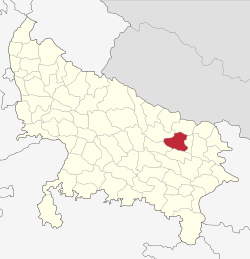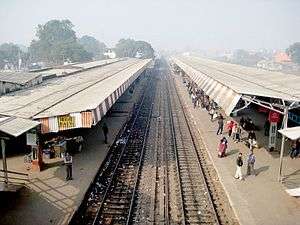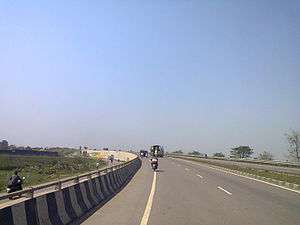Basti district
| Basti district बस्ती जिला | |
|---|---|
| District of Uttar Pradesh | |
 Location of Basti district in Uttar Pradesh | |
| Country | India |
| State | Uttar Pradesh |
| Administrative division | Basti |
| Government | |
| • Lok Sabha constituencies | Basti |
| Area | |
| • Total | 4,309 km2 (1,664 sq mi) |
| Population (2011) | |
| • Total | 2,461,056 |
| • Density | 570/km2 (1,500/sq mi) |
| • Urban | 138,117 |
| Demographics | |
| • Literacy | 69.69 per cent |
| • Sex ratio | 962 |
| Major highways | National Highway 28 |
| Average annual precipitation | 1166 mm mm |
| Website | Official website |
Basti district (Hindi: बस्ती जिला, Urdu: ضلع بستی), is one of the districts of Uttar Pradesh state, India and Basti town is the district headquarters. Basti district is a part of Basti Division. The ruins of Mahua Dabar town are located in the Basti district.
Origin of name
Basti News Website :- Basti Khabar (Hindi News Portal) Basti came from the original name basisthi, Basisth the great sage ashram situated in this area [1] Sher Shah Suri made a well and a sarai here and hence receiving the name.
In 1801, the town Basti became a tehsil headquarter, and in 1865, it was chosen as the headquarters of the newly established Basti district of Gorakhpur Commissionary.[2]
Geography
The district lies between the parallels of 26° 23' and 27° 30' North and Latitude and 82° 17' and 83° 20' East longitude. Its maximum length from north to south is about 75 km. and breadth from east to west about 70 km. The district lies between newly created district Sant Kabir Nagar on the east and Gonda on the west On the south, the Ghaghra river near Amorha Khas previously known as Amorha Province or State of Raja Zalim Singh separates it from the Faizabad and newly created district named Ambedkar Nagar. While on the North it is bounded by district Sidharth Nagar.[3][4][5]
Demographics
According to the 2011 census, Basti district has a population of 2,461,056, and almost all of population lives in rural villages,[6] which roughly equals to that of Kuwait[7] or the US state of Nevada.[8] This ranks it the 179th populous district in India.[6] The district has a population density of 916 inhabitants per square kilometre (2,370/sq mi).[6] Its population growth rate over the decade 2001-2011 was 18.05%.[6] Basti has a sex ratio of 959 females for every 1000 males,[6] and a literacy rate of 69.69%.[6] The sex ratio of Basti is 959, better than the national sex ratio of 940.27 but better than Uttar Pradesh's 908. The child sex ratio of Basti is 922, which again is better than the national average of 914 female children per 1000 males.
Languages
Vernaculars spoken in the district include Awadhi in western areas and Bhojpuri in the eastern side. The district Basti may be considered as the demarcation of the languages Awadhi and Bhojpuri. In city, due to increase in educated population, khari boli of Hindi is also observed in daily conversations.[9]
Education
The district follows a usual 10+2+3 pattern of education as elsewhere in India. Some notable schools and institutions of the district are :
- St. Basils School (affiliated to CISCE)[10]
- St. Xavier's Senior Secondary School
- Karma Devi Smriti Mahavidyalaya [11]
- Jawahar Navodaya Vidyalaya Basti [12]
- All India Institute of Information Technology (Institute for Computer Education) [13]
- Little Flower High School Kalwari Basti [14][15][16]
Administration
Basti town is the district headquarters of the district.[1] Basti district, a part of Basti division, is formed of 4 tehsils: Basti, Harriya, Sonaha Bhanpur and Rudhauli, and 13 development blocks, 139 Nyay Panchayats, 1 Pargana named Amorha as well as 10 Gram Sabhas. The development blocks included are:
.jpg)
.jpg)
- Amorha or Amodha
- Basti
- Bahadurpur
- Bankati
- Dubauliya
- Gaur
- Harraiya
- Kaptanganj
- Kudaraha
- Paras Rampur
- Ramnagar
- Rudhauli
- Saltaua Gopal Pur
- Sau Ghat or Amari Bazar
- Vikram Jot
- Kudraha
Economy
The district is noted for its cotton textiles and sugar industries. Cottage industries and small-scale industries including the manufacturing units of brass ware, iron and carpentry goods, agricultural implements, bricks, agro-products, foot-wear, soaps, candles, and pottery are present here. Basti is also known for its bamboo, eucalyptus (Eucalyptus teritrornis), mango and shisham (Dalbergia sissoo) populations. Three sugar factories are housed in the district. Sugarcane, maize, paddy, pulses, wheat, barley and potato are commonly cultivated. The most of the population is depending for their livelihood on agricultural practices. The district is well connected through NH 28 which reflects on its good economy. The city is well connected through railways also.

In 2006 the Ministry of Panchayati Raj named Basti one of the country's 250 most backward districts (out of a total of 640).[17] It is one of the 34 districts in Uttar Pradesh currently receiving funds from the Backward Regions Grant Fund Programme (BRGF).[17] The City is also known as the place where Nationwide Youth organisation "National Association of Youth" founded and run from Basti.[18]
Transportation

The main line connecting Lucknow with Gorakhpur and places in Bihar and Assam in the east passes through the south of the district. The main line has 7 railway stations which are, from east to west, Munderwa,[19] Orwara, Basti, Govindnagar, Tinich, Gaur, and Babhnan within the district. There is a daily Intercity express between Gorakhpur, Basti, Gonda and Lucknow. National Highway 28, a part of the East West Corridor project of Government of India and NHAI,[20] also passes through Basti.
Flora and fauna
The forest cover of the district has dwindled with increasing use of land for agriculture. There are areas with high prevalence of mango (Mangifera indica), mahua (Madhuca longifolia), sal (Shorea robusta), and bamboo (Bambusa arundinacea) trees. Some of the wild animals of the district are the nilgai (Boselaphus tragocamelus), antelok (Anelok cervicapra), pig (Sus scrofa), wolf (Canis lupus), jackal (Conis aureus), fox (Vulpes bengalensis), hare (Lepus ruficandatus), monkey (Macaca mulatta), wild cat (Felis bengalensis) and the porcupine (Hystric leucura). Several species of game birds are also seen, including the peafowl (Pavo cristatus), the black partridge (Frencolinus francolinus) and the gray partridge (Francalinus pondicervanus). A number of migratory water fowls visit the water bodies of the district in winter, such as the goose (Anser anser), common teal (Anas crecca), red-crested pochard (Netta rufina), white-eyed pochard (Aythya rufa) and the wigeon (Mareca penelope). The cobra (Naja naja), krait (Bungarus caeruleus), and rat-snake (Ptyas mucosus) are commonly found. The Indian crocodile or naka (Crocodylus palustris), and the ghariyal (Gavialis gangeticus) are also found in the river Ghaghra. The common fish species are rohu (Lebeo rohita), bhakur (Catla catla), nain (Cirrhina mrigala), parhin (Wallagonia attu), krunch (Labeo calbasu), and tengan (Mystus seenghala).[1]
Notable people
Some notable persons from the district include:
- Ramchandra Shukla, who is regarded as the first codifier of the history of Hindi literature in a scientific system.
- Sarveshwar Dayal Saxena - a Hindi poet who received the government Sahitya Academy prize.
- Jagdambika Pal - Former chief minister of UP Government.
- Harish Dwivedi - Member of Parliament from Bharatiya Janata Party adopted Amorha Khas Gram Panchayat and Agauna Gram Panchayat, birthplace of Ramchandra Shukla in Basti district, Uttar Pradesh.
- Obaid Siddiqi, an eminent biologist (geneticist), referred to as the founder of the Modern Biology in India. Founded TIFR (Molecular Biology Dep.) and NCB,Bangalore.
[Hiyaram Chaudhary], an social worker, from bahujan samajvadi party, gram Piprakaji.
References
- 1 2 3 "Origin of name". Basti Govt. Retrieved 13 March 2014.
- ↑ http://basti.nic.in/general%20profile/general%20profile.htm
- ↑ http://basti.nic.in/general%20profile/Geography%20of%20basti.htm
- ↑ "Yahoo maps location of Basti". Yahoo maps. Retrieved 2009-03-29.
- ↑ Thomas, David (17 December 1998). "Battles & Honours of Royal Navy". Pen and Sword. Retrieved 25 July 2016 – via Google Books.
- 1 2 3 4 5 6 "District Census 2011". Census2011.co.in. 2011. Retrieved 2011-09-30.
- ↑ US Directorate of Intelligence. "Country Comparison:Population". Retrieved 2011-10-01.
Kuwait 2,595,62
- ↑ "2010 Resident Population Data". U. S. Census Bureau. Archived from the original on 19 October 2013. Retrieved 2011-09-30.
Nevada 2,700,551
- ↑ Gopeshwar Tripathi, ed. (2009). "Bhojpuri: A language of India". Ethnologue: Languages of the World (16th ed.). Dallas, Texas: SIL International. Retrieved 2011-09-30.
- ↑ "Home page". Retrieved 26 July 2013.
- ↑ "Karma Devi Smriti Mahavidyalaya". Archived from the original on 25 February 2015. Retrieved 25 February 2015.
- ↑ "JNV". Retrieved 3 May 2014.
- ↑ "AIIIT". Retrieved 14 June 2015.
- ↑ "Catholic Diocese of Gorakhpur". www.dioceseofgorakhpur.org. Retrieved 2016-02-03.
- ↑ "LITTLE FLOWER H S KALWARI BASTI". upmspboard.com. Retrieved 2016-02-03.
- ↑ "Welcome to Little Flower Congregation (Gorakhpur Nepal). Little Flower Congregation (CST Fathers),Ashrams & Institutions, Kalwari,Little Flower Ashram". cstfathersgorakhpur.org. Retrieved 2016-02-03.
- 1 2 Ministry of Panchayati Raj (8 September 2009). "A Note on the Backward Regions Grant Fund Programme" (PDF). National Institute of Rural Development. Archived from the original (PDF) on 5 April 2012. Retrieved 27 September 2011.
- ↑ "NAY". Retrieved 18 Jan 2016.
- ↑ "Welcome - Munderwa". Retrieved 4 October 2014.
- ↑ "Welcome to NHAI". Archived from the original on 4 March 2016. Retrieved 25 July 2016.
External links
- Official website of Basti (U.P.) administration
- Munderwa, Basti District
- Introduction - Basti District
- Agriculture Basti
- Basti District map
- District Court of Basti
 |
Siddharthnagar district |  | ||
| Gonda district | |
Sant Kabir Nagar district | ||
| ||||
| | ||||
| Faizabad district | Ambedkar Nagar district |
Coordinates: 27°15′N 83°00′E / 27.250°N 83.000°E